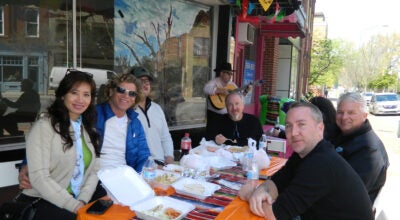High Rock Raceway timeline
Published 12:00 am Sunday, March 15, 2015
The High Rock Raceway development that was planned for the site of the former Color-Tex plant off US 29 near the Yadkin River was an ordeal that went on for years. It came to and end in late 2009 after a lawsuit forced the sale of the property at auction. Below is a timeline the Post published in 2009 chronicling the events. Read our story about the property here.
Oct. 1, 2000: Color-Tex, the former N.C. Finishing Co., closes and files for bankruptcy, leaving 350 employees jobless.
October 2001: David Risdon, a Boston investment banker who sat on the Color-Tex board of directors, acquires the property and pledges to pay $160,000 owed the former Color-Tex employees when the company closed.
Feb. 23, 2005: Risdon announces plans for a 2-mile road-racing course as part of a luxury development on the banks of the Yadkin River. It will be called High Rock International Raceway. Alan Wilson, designer of 60 tracks worldwide, will design the track.
Risdon says the first sanctioned races would most likely take place in 2007.
June 5, 2005: A stripped down version of the project— minus chalets, condos and a country club — goes to Rowan County commissioners. The owners announce plans to seek protection of a Brownfields agreement to deal with known and unknown hazards on the former textile mill site.
Risdon says his focus is to get the track open by February 2007.
Aug. 17, 2005: County commissioners approve a conditional-use permit for the race track, although county planners say documents submitted by Risdon contain errors and some documents are missing.
Chairman Arnold Chamberlain observes that “the project is not proceeding in a professional manner.”
Nov. 13, 2005: Plans for the race track are put on hold when S.M. Rapid Funding forecloses and schedules a sale of the 240-acre site property on the courthouse steps.
The company gives Risdon a three month extension to pay off the $500,000 loan.
Risdon asks Spencer to annex the property.
March 15, 2006: The Spencer Board of Aldermen moves forward with a voluntary annexation petition for the former Color-Tex property and site of the planned race track.
Risdon tells aldermen his company, High Rock Properties, plans to secure funding for the main track within two months and begin grading. He says the track should be finished by December and open to the public in February 2007.
“There’s no other track like this in North Carolina,” Risdon says.
May 10, 2006: Spencer Aldermen annex the site of the planned raceway, billed as a $20 million motorsports complex.
Risdon tells aldermen he has paid off debts and is in the last stage of raising the money necessary to build the track.
August 2006: Spencer issues a conditional-use permit for the track.
Sept. 21, 2006: Spencer officials decide to redo the conditional-use permit after the Trading Ford Historic District Preservation Association challenges the town’s procedures in court. Officials admit the town may not have followed public notice requirements.
November 2006: A trackhoe operator releases sludge from holding ponds, contaminating a creek that flows into the Yadkin River.
July 29, 2007: Spencer aldermen take a third shot at issuing a conditional-use permit for High Rock Raceway. Zoning Board members had asked Risdon to withdraw his application nine months earlier because of incomplete information.
Aug. 10, 2007: Spencer approves a conditional-use permit for High Rock Raceway, now billed as a 2-mile road course expected to cost $28 million. Risdon says he expects to have the required erosion control permit and start work within three months.
Aug. 28, 2007: Risdon agrees to stop grading on the race track until he gets proper permits from the county.
Sept. 08, 2007: Risdon says he hopes to pay a substantial portion of the money owed to former Color-Tex workers, promising to use money from the sale of memberships at the track.
Sept. 25, 2007: Rowan County goes to court to stop grading at the track after workers ignore a stop-work order and continue grading without submitting erosion control plan as required by the state.
Sept. 27, 2007: Superior Court Judge Larry Ford signs a restraining order requiring Risdon to cease and desist immediately any land-disturbing activity. County officials sought the order after crews working for Risdon continued working despite a stop-work order and Risdon ignored a requirement to submit an erosion control plan.
Risdon said photos of grading equipment on the track Web site showing “construction of the race track” were a mistake and were taken off the site.
Oct 5, 2007: Risdon, president of what is now High Rock Raceway, expresses confidence that he can get a crossing agreement with Norfolk Southern to allow access across its railroad tracks.
Oct. 9, 2007: Risdon agrees to a consent order to halt all work at the site and submit a comprehensive erosion control plan within 45 days.
In a statement on the High Rock Raceway Web site, he notes that due in part to the erosion issue the spring 2008 opening is unlikely. “We feel that a summer 2008 target opening date at this point is more realistic.”
Dec. 22, 2007: Heavy equipment knocks down the last walls of the former N.C. Finishing Plant. Risdon estimates it will take three to four months to clean up the site. Risdon says a tribute to the millworkers will be built on the site, after the race track is completed in the summer or early fall of 2008.
Jan. 16, 2008: A groundbreaking is held for the race track. Risdon also acknowledges that a story posted on the High Rock Raceway Web site was an error. The story, which remained on the site for two weeks, claimed Sir Richard Branson, the billionaire owner of Virgin Airlines, was a partner in the venture.
Feb. 27, 2008: Richard F. “Rich” Combs, of Atlanta, is named the new president and chief operating officer of High Rock Raceway. He vows the project is on the fast track to completion and plans to invest a significant amount of his money in the project.
“Dave and I are on the same page. We see eye-to-eye on a lot of things,” Combs says.
May 23, 2008: Risdon pays a $5,000 fine to the county for failure to follow an approved clearing and grubbing plan to avoid court action to shut down the project. “It’s deja vu all over again with the race track,” says Lloyd Pace, codes enforcement officer. Risdon blames problems on the grading contractor.
July 6, 2008: Combs says getting financing has been slow, but he expresses confidence the project will happen.
Oct. 28, 2008: Risdon confirms that Rich Combs is no longer affiliated with the race track and that he has returned to Atlanta to tend to banking business. Investors in townhouses learn of Combs’ departure when they call his cell phone and Risdon and McGuire return the calls.
May 13, 2009: Spencer aldermen approve a development agreement concerning the race track that covers a 20-year working agreement for the track and other proposed residential and commercial development. The agreement is with High Rock Raceway and TMS Inc., a New York City-based company that Risdon says will take over development and provide funding.
June 11, 2009: Risdon is ousted from the project with longtime partner Frank McGuire and his daughter, Ellen McGuire, now in charge.
June 16, 2009: In an email to the Post, Risdon says he hopes the remaining partners can make a go of the track, but that “the basic problem we have had is that the funding is not there.” It’s a reversal of Risdon’s repeated assurances over the years that funding for the project is in place or forthcoming.
In a follow-up e-mail the same day, Risdon says he was assured by TMS that funding would be provided, but it didn’t happen.
“I finally figured out that I had been had,” Risdon wrote.
Sept. 25. A judge rules in favor of Anthony M. Flores, a Greensboro veterinarian, who filed a lawsuit against High Rock Properties to recover the $25,000 he put down on a planned townhouse at the site. The judge rules the property must be sold to satisfy Flores’ lien against it.
Dec. 4, 2009. Donald Rand, who runs Spinnaker General Contracting, wins the initial auction for the property with a high bid of $800. But because of a rule allowing an “up-set” bid to come in within 10 days of the auction, the sale would gone for months.
June 4, 2010. Rand is finally awarded the property with a high bid of $25,525.




